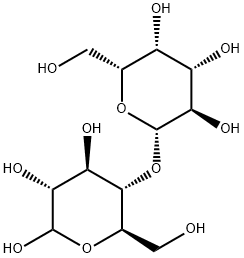PRODUCT Properties
| Melting point: | 222.8°C |
| Boiling point: | 397.76°C (rough estimate) |
| Density | 1.5300 |
| refractive index | 1.5376 (estimate) |
| storage temp. | 2-8°C |
| solubility | Freely but slowly soluble in water, practically insoluble in ethanol (96 per cent). |
| form | Powder |
| pka | 12.39±0.20(Predicted) |
| color | White to Off-white |
| Odor | Mildly sweet taste. |
| optical activity | Alpha form +85.0 → +52.6 Beta form +34.9 → +55.4 |
| Water Solubility | 5-10 g/100 mL at 20 ºC |
| BRN | 93796 |
| Stability: | Stable. Incompatible with strong oxidizing agents. |
| LogP | -3.391 (est) |
| CAS DataBase Reference | 63-42-3(CAS DataBase Reference) |
| NIST Chemistry Reference | D-Glucose, 4-o-«beta»-D-galactopyranosyl-(63-42-3) |
| EPA Substance Registry System | Lactose (63-42-3) |
Description and Uses
Lactose is a disaccharide carbohydrate that occurs in mammalian milk except that of the whale and the hippopotamus. it is princi- pally obtained as a cows’ milk derivative. it is also termed milk sugar and it is a reducing sugar consisting of glucose and galactose. its most common commercial form is alpha-monohydrate, with the beta-anhydride form available to a lesser extent. all forms in solution will equilibrate to a beta:alpha ratio of 62.25:37.75 at 0°c. it is about one-sixth as sweet as sugar and is less soluble. it functions as a flow agent, humectant, crystallization control agent, and sweetener. it is used in baked goods for flavor, browning, and tenderizing and in dry mixes as an anticaking agent.
Safety
| Safety Statements | 24/25 |
| WGK Germany | 2 |
| RTECS | OD9625000 |
| TSCA | Yes |
| HS Code | 17021100 |
| Hazardous Substances Data | 63-42-3(Hazardous Substances Data) |






